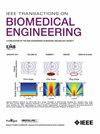A New Multi-Mode, High Pressure Portable Transcranial Ultrasound Stimulation System
IF 4.5
2区 医学
Q2 ENGINEERING, BIOMEDICAL
引用次数: 0
Abstract
新型多模式、高压便携式经颅超声波刺激系统
目的:经颅超声刺激(TUS)是一种治疗脑部疾病的前景广阔的非侵入性神经调节方法。研究中常用的 TUS 系统包括定制设备和商用设备。定制设备通常由传统的函数发生器、功率放大器和超声换能器组成。由于接线繁琐且没有专用的控制软件,这些设备的操作很不方便。商用设备通常只有有限的波形模式,无法进行复杂波形的超声调制。这些局限性限制了普通用户对 TUS 技术的应用。因此,我们提出了一种具有多种模式和高声压的便携式 TUS 系统:方法:所提出的便携式 TUS 系统利用大功率多模式刺激器和带阻抗匹配模块的超声换能器来实现多模式和高声压超声神经调制:该刺激器可输出四种波形:连续脉冲连续刺激(CPCS)、间歇脉冲连续刺激(IPCS)、连续脉冲间歇刺激(CPIS)和间歇脉冲间歇刺激(IPIS)。当使用相同的传感器时,它产生的负压峰值与商用设备产生的负压峰值几乎相同。与商用传感器相比,我们的传感器产生的峰值负压明显更高,最大可达 0.95 兆帕:结论:我们使用大鼠海马脑片进行了体外实验。实验结果证明了 TUS 系统对神经刺激的有效性:意义:提供了一种用于复杂神经调控研究的便携式多模式高压 TUS 系统的设计方法。
本文章由计算机程序翻译,如有差异,请以英文原文为准。
求助全文
约1分钟内获得全文
求助全文
来源期刊

IEEE Transactions on Biomedical Engineering
工程技术-工程:生物医学
CiteScore
9.40
自引率
4.30%
发文量
880
审稿时长
2.5 months
期刊介绍:
IEEE Transactions on Biomedical Engineering contains basic and applied papers dealing with biomedical engineering. Papers range from engineering development in methods and techniques with biomedical applications to experimental and clinical investigations with engineering contributions.
 求助内容:
求助内容: 应助结果提醒方式:
应助结果提醒方式:


